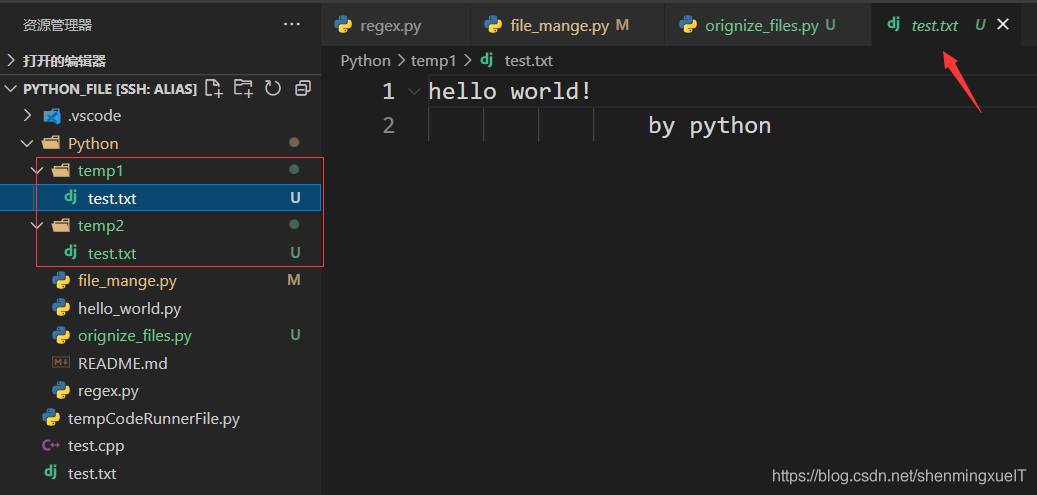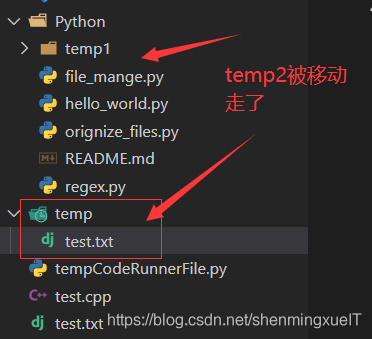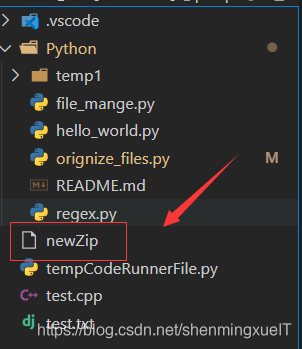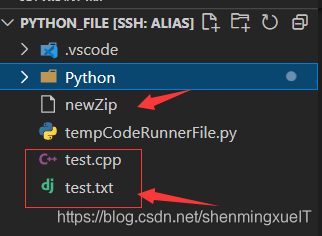жӮЁеҘҪпјҢзҷ»еҪ•еҗҺжүҚиғҪдёӢи®ўеҚ•е“ҰпјҒ
еҰӮдҪ•дҪҝз”Ёpythonз»„з»Үж–Ү件пјҹеҫҲеӨҡж–°жүӢеҜ№жӯӨдёҚжҳҜеҫҲжё…жҘҡпјҢдёәдәҶеё®еҠ©еӨ§е®¶и§ЈеҶіиҝҷдёӘйҡҫйўҳпјҢдёӢйқўе°Ҹзј–е°ҶдёәеӨ§е®¶иҜҰз»Ҷи®Іи§ЈпјҢжңүиҝҷж–№йқўйңҖжұӮзҡ„дәәеҸҜд»ҘжқҘеӯҰд№ дёӢпјҢеёҢжңӣдҪ иғҪжңүжүҖ收иҺ·гҖӮ
shutilе…¶е®һд№ҹе°ұжҳҜshellжЁЎеқ—гҖӮе…¶дёӯеҢ…еҗ«дёҖдәӣеҮҪж•°пјҢеҸҜд»Ҙи®©жҲ‘们еңЁpythonзЁӢеәҸдёӯеӨҚеҲ¶гҖҒ移еҠЁгҖҒж”№еҗҚе’ҢеҲ йҷӨж–Ү件гҖӮ
shutil.copy(sourceпјҢdestination)пјҡе°Ҷи·Ҝеҫ„sourceеӨ„зҡ„ж–Ү件еӨҚеҲ¶еҲ°и·Ҝеҫ„destinationеӨ„зҡ„ж–Ү件еӨ№гҖӮеҰӮжһңdestinationжҳҜдёҖдёӘж–Ү件еҗҚпјҢйӮЈд№Ҳе®ғе°ҶдҪңдёәиў«еӨҚеҲ¶зҡ„ж–°еҗҚеӯ—
shutil.copytree(source,destination)пјҡе°Ҷи·Ҝеҫ„sourceеӨ„зҡ„ж–Ү件еӨ№пјҢеҢ…жӢ¬е®ғзҡ„жүҖжңүж–Ү件е’Ңеӯҗж–Ү件еӨ№пјҢеӨҚеҲ¶еҲ°и·Ҝеҫ„destinationеӨ„зҡ„ж–Ү件еӨ№гҖӮ
import shutil import os current_path = os.getcwd() # жӢ·иҙқtest.txt ж–Ү件еҲ°temp1ж–Ү件еӨ№дёӢ shutil.copy(current_path+"/test.txt",current_path+"/Python/temp1") # е°Ҷtemp1ж–Ү件еӨ№еҶ…е®№жӢ·иҙқеҲ°temp2ж–Ү件еӨ№дёӢ,жӯӨж—¶дјҡеҲӣе»әtemp2ж–Ү件еӨ№ shutil.copytree(current_path+"/Python/temp1",current_path+"/Python/temp2")
з»“жһңпјҡ

shutil.move(source,destination)пјҡе°ҶsourceеӨ„зҡ„ж–Ү件еӨ№з§»еҠЁеҲ°и·Ҝеҫ„destinationпјҢ并иҝ”еӣһж–°дҪҚзҪ®зҡ„з»қеҜ№и·Ҝеҫ„зҡ„еӯ—з¬ҰдёІ
жіЁпјҡ
еҰӮжһңdestinationжҢҮеҗ‘дёҖдёӘж–Ү件еӨ№пјҢsourceж–Ү件е°Ҷ移еҠЁеҲ°destinationдёӯпјҢ并дҝқжҢҒеҺҹжқҘзҡ„ж–Ү件еҗҚпјӣ
еҰӮжһңdestinationжҢҮеҗ‘дёҖдёӘж–Ү件пјҢиҝҷдёӘж–Ү件е°ұдјҡиў«иҰҶзӣ–пјҢжіЁж„ҸпјҒ
еҰӮжһңdestinationжҢҮеҗ‘дёҖдёӘдёҚеӯҳеңЁзҡ„ж–Ү件еӨ№пјҢиҝҷдёӘж—¶еҖҷsourceйҮҢйқўзҡ„еҶ…е®№дјҡ移еҠЁеҲ°destinationпјҢsourceж”№еҗҚдёәdestination
import shutil import os current_path = os.getcwd() # е°Ҷtemp2ж–Ү件еӨ№еҶ…зҡ„ж–Ү件жӢ·иҙқеҲ°tempдёӯ,并е°Ҷtemp2ж”№еҗҚдёәtemp shutil.move(current_path+"/Python/temp2",current_path+"/temp")
з»“жһңпјҡ

os.unlink(path)пјҡе°ҶеҲ йҷӨpathеӨ„зҡ„ж–Ү件
os.rmdir(path)пјҡе°ҶеҲ йҷӨpathеӨ„зҡ„ж–Ү件еӨ№гҖӮиҜҘж–Ү件еӨ№еҝ…йЎ»дёәз©әпјҢе…¶дёӯжІЎжңүд»»дҪ•ж–Ү件е’Ңж–Ү件еӨ№
shutil.retree(path)пјҡе°ҶеҲ йҷӨpathеӨ„зҡ„ж–Ү件еӨ№пјҢе®ғеҢ…еҗ«зҡ„жүҖжңүж–Ү件е’Ңж–Ү件еӨ№йғҪдјҡиў«еҲ йҷӨ
import shutil import os current_path = os.getcwd() shutil.rmtree(current_path+"/temp")
з»“жһңпјҡ

os.walk(path)пјҡйҖҡиҝҮдј е…ҘдёҖдёӘи·Ҝеҫ„
os.walk()еңЁеҫӘзҺҜзҡ„жҜҸж¬Ўиҝӯд»ЈдёӯпјҢиҝ”еӣһдёүдёӘеҖјпјҡ
1.еҪ“еүҚж–Ү件еӨ№еҗҚз§°зҡ„еӯ—з¬ҰдёІ
2.еҪ“еүҚж–Ү件еӨ№дёӯеӯҗж–Ү件еӨ№зҡ„еӯ—з¬ҰдёІзҡ„еҲ—иЎЁ
3.еҪ“еүҚж–Ү件еӨ№дёӯж–Ү件зҡ„еӯ—з¬ҰдёІзҡ„еҲ—иЎЁ
import shutil
import os
current_path = os.getcwd()
for folder_name,sub_folders,file_names in os.walk(current_path):
print(folder_name+":")
# еҠ иҪҪеҪ“еүҚж–Ү件и·Ҝеҫ„дёӢзҡ„жүҖжңүеӯҗж–Ү件
for sub_folder in sub_folders:
print("\t"+folder_name+": "+sub_folder+"(dir)")
for file_name in file_names:
print("\t"+folder_name+": "+file_name)иҫ“еҮәпјҲйғЁеҲҶ)пјҡ
ubuntu@VM-0-2-ubuntu:~/python_file$ /usr/bin/python3 /home/ubuntu/python_file/Python/orignize_files.py
/home/ubuntu/python_file:
/home/ubuntu/python_file: .vscode(dir)
/home/ubuntu/python_file: Python(dir)
/home/ubuntu/python_file: test.cpp
/home/ubuntu/python_file: test.txt
/home/ubuntu/python_file: tempCodeRunnerFile.py
/home/ubuntu/python_file/.vscode:
/home/ubuntu/python_file/.vscode: db(dir)
/home/ubuntu/python_file/.vscode: .git(dir)
/home/ubuntu/python_file/.vscode: log(dir)
/home/ubuntu/python_file/.vscode: settings.json
/home/ubuntu/python_file/.vscode/db:
/home/ubuntu/python_file/.vscode/db: cpptips.db-wal
/home/ubuntu/python_file/.vscode/db: cpptips.db-shm
/home/ubuntu/python_file/.vscode/db: cpptips.db
/home/ubuntu/python_file/.vscode/.git:
/home/ubuntu/python_file/.vscode/.git: 6eb7a60f73d1a1d9bdf44f2e86d7f4cc_test.cpp
/home/ubuntu/python_file/.vscode/log:
/home/ubuntu/python_file/.vscode/log: cpptips.server.2021-05-19.log
/home/ubuntu/python_file/.vscode/log: cpptips.server.2021-05-16.log
/home/ubuntu/python_file/.vscode/log: cpptips.server.2021-05-17.log
/home/ubuntu/python_file/.vscode/log: cpptips.client.log
/home/ubuntu/python_file/.vscode/log: cpptips.server.log
/home/ubuntu/python_file/Python:
/home/ubuntu/python_file/Python: temp1(dir)
/home/ubuntu/python_file/Python: .git(dir)
/home/ubuntu/python_file/Python: README.md
/home/ubuntu/python_file/Python: hello_world.py
/home/ubuntu/python_file/Python: orignize_files.py
/home/ubuntu/python_file/Python: regex.py
/home/ubuntu/python_file/Python: file_mange.py
.........
.........
.........
еҲ©з”ЁzipfileжЁЎеқ—дёӯзҡ„еҮҪж•°пјҢpythonзЁӢеәҸеҸҜд»ҘеҲӣе»әе’Ңжү“ејҖZIPж–Ү件гҖӮ
жғіиҰҒеҲӣе»әZIPж–Ү件пјҢеҝ…йЎ»з”ЁZipFileж–№жі•еҲӣе»әдёҖдёӘZipFileеҜ№иұЎгҖӮZipFileеҜ№иұЎеңЁжҰӮеҝөдёҠе’ҢFileеҜ№иұЎзӣёдјјгҖӮ
д№ӢеҗҺпјҢд»ҘеҶҷжЁЎејҸжү“ејҖиҝҷдёӘеҜ№иұЎгҖӮи°ғз”Ёwrite()ж–№жі•дј е…ҘдёҖдёӘи·Ҝеҫ„пјҢpythonе°ұдјҡеҺӢзј©иҜҘи·Ҝеҫ„жүҖжҢҮзҡ„ж–Ү件пјҢе°Ҷе®ғеҠ еҲ°ZIPж–Ү件дёӯгҖӮwriteзҡ„第дёҖдёӘеҸӮж•°жҳҜдёҖдёӘеӯ—з¬ҰдёІпјҢд»ЈиЎЁиҰҒж·»еҠ зҡ„ж–Ү件еҗҚгҖӮ第дәҢдёӘеҸӮж•°жҳҜвҖқеҺӢзј©зұ»еһӢвҖңеҸӮж•°пјҢе‘ҠиҜүи®Ўз®—жңәдҪҝз”ЁжҖҺж ·зҡ„з®—жі•жқҘеҺӢзј©ж–Ү件гҖӮдёҖиҲ¬жқҘиҜҙпјҢZIP_DEFLATEDе°ұеҸҜд»ҘдәҶгҖӮ
import zipfile
import os
current_path = os.getcwd()
new_zip = zipfile.ZipFile("newZip","w")
new_zip.write("test.txt",compress_type=zipfile.ZIP_DEFLATED)
new_zip.write("test.cpp",compress_type=zipfile.ZIP_DEFLATED)з»“жһңпјҡ

еҪ“з”ЁZipFileеҮҪж•°жү“ејҖдёҖдёӘzipж–Ү件зҡ„ж—¶еҖҷпјҢдјҡиҝ”еӣһдёҖдёӘZipFileеҜ№иұЎгҖӮд№ӢеҗҺи°ғз”ЁиҝҷдёӘеҜ№иұЎзҡ„namelist()ж–№жі•е°ұеҸҜд»ҘиҺ·еҫ—zipйҮҢйқўзҡ„еҺӢзј©ж–Ү件еҲ—иЎЁгҖӮ
еҗҢж—¶иҝҷдёӘеҜ№иұЎиҝҳжңүдёҖдёӘgetinfo()ж–№жі•пјҢйҖҡиҝҮдј е…ҘдёҖдёӘеҺӢзј©ж–Ү件еҗҚпјҢе°ұеҸҜд»ҘиҺ·еҫ—иҝҷдёӘж–Ү件зҡ„дёҖдәӣдҝЎжҒҜгҖӮ
import zipfile
import os
current_path = os.getcwd()
new_zip = zipfile.ZipFile("newZip","r")
files = new_zip.namelist()
for file in files:
info = new_zip.getinfo(file)
print("filename: "+file)
print("\tsize: "+str(info.file_size))
print("\tcompress_size: "+str(info.compress_size))иҫ“еҮәпјҡ
ubuntu@VM-0-2-ubuntu:~/python_file$ /usr/bin/python3 /home/ubuntu/python_file/Python/orignize_files.py
filename: test.txt
size: 26
compress_size: 26
filename: test.cpp
size: 30
compress_size: 28
ZipFileеҜ№иұЎзҡ„extractallж–№жі•д»ҺZIPж–Ү件дёӯи§ЈеҺӢзј©жүҖжңүзҡ„ж–Ү件е’Ңж–Ү件еӨ№пјҢж”ҫеҲ°еҪ“еүҚе·ҘдҪңзӣ®еҪ•дёӢпјҡ
import zipfile
import os
current_path = os.getcwd()
example_zip = zipfile.ZipFile("newZip","r")
# и§ЈеҺӢ
example_zip.extractall()
example_zip.close()з»“жһңпјҡ

Pythonдё»иҰҒеә”з”ЁдәҺпјҡ1гҖҒWebејҖеҸ‘пјӣ2гҖҒж•°жҚ®з§‘еӯҰз ”з©¶пјӣ3гҖҒзҪ‘з»ңзҲ¬иҷ«пјӣ4гҖҒеөҢе…ҘејҸеә”з”ЁејҖеҸ‘пјӣ5гҖҒжёёжҲҸејҖеҸ‘пјӣ6гҖҒжЎҢйқўеә”з”ЁејҖеҸ‘гҖӮ
зңӢе®ҢдёҠиҝ°еҶ…е®№жҳҜеҗҰеҜ№жӮЁжңүеё®еҠ©е‘ўпјҹеҰӮжһңиҝҳжғіеҜ№зӣёе…ізҹҘиҜҶжңүиҝӣдёҖжӯҘзҡ„дәҶи§ЈжҲ–йҳ…иҜ»жӣҙеӨҡзӣёе…іж–Үз« пјҢиҜ·е…іжіЁдәҝйҖҹдә‘иЎҢдёҡиө„и®Ҝйў‘йҒ“пјҢж„ҹи°ўжӮЁеҜ№дәҝйҖҹдә‘зҡ„ж”ҜжҢҒгҖӮ
е…ҚиҙЈеЈ°жҳҺпјҡжң¬з«ҷеҸ‘еёғзҡ„еҶ…е®№пјҲеӣҫзүҮгҖҒи§Ҷйў‘е’Ңж–Үеӯ—пјүд»ҘеҺҹеҲӣгҖҒиҪ¬иҪҪе’ҢеҲҶдә«дёәдё»пјҢж–Үз« и§ӮзӮ№дёҚд»ЈиЎЁжң¬зҪ‘з«ҷз«ӢеңәпјҢеҰӮжһңж¶үеҸҠдҫөжқғиҜ·иҒ”зі»з«ҷй•ҝйӮ®з®ұпјҡis@yisu.comиҝӣиЎҢдёҫжҠҘпјҢ并жҸҗдҫӣзӣёе…іиҜҒжҚ®пјҢдёҖз»ҸжҹҘе®һпјҢе°Ҷз«ӢеҲ»еҲ йҷӨж¶үе«ҢдҫөжқғеҶ…е®№гҖӮ
жӮЁеҘҪпјҢзҷ»еҪ•еҗҺжүҚиғҪдёӢи®ўеҚ•е“ҰпјҒ